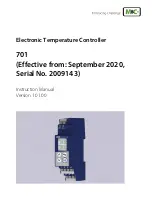
See examples below.
EXAMPLE 1:
In order to reduce the error value to zero, with the given values, the AC drive output behaves
as follows:
Given values:
P2.1.12, P = 0%
P2.1.13, I-time = 1.00 s
P2.1.14, D-time = 0.00 sMin freq. = 0 Hz
Error value (setpoint – process value) = 10.00%Max freq. = 50 Hz
In this example, the PID controller operates practically as I-controller only.
According to the given value of parameter 2.1.13 (I-time), the PID output increases by 5 Hz
(10% of the difference between the maximum and minimum frequency) every second until
the error value is 0.
Hz
t
1s
Error=10%
10%
10%
10%
10%I-Part=5 Hz/s
I-Part=5 Hz/s
I-Part=5 Hz/s
I-Part=5 Hz/s
I-Part=5 Hz/s
PID output
Error value
Fig. 27: PID controller function as I-controller
EXAMPLE 2
Given values:
P2.1.12, P = 100%
P2.1.13, I-time = 1.00 s
P2.1.14, D-time = 1.00 sMin freq. = 0 Hz
Error value (setpoint – process value) = ±10%Max freq. = 50 Hz
As the power is switched on, the system detects the difference between the setpoint and the
actual process value and starts to either raise or decrease (in case the error value is
negative) the PID output according to the I-time. Once the difference between the setpoint
and the process value has been reduced to 0 the output is reduced by the amount
corresponding to the value of parameter 2.1.13.
In case the error value is negative, the AC drive reacts reducing the output correspondingly.
VACON · 244
PARAMETER DESCRIPTIONS
8
TEL. +358 (0)201 2121 · FAX +358 (0)201 212 205
















































